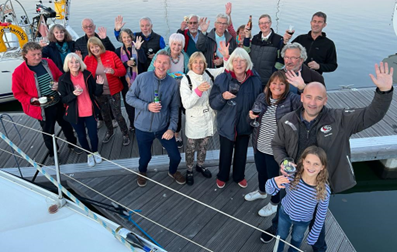- This topic is empty.
-
AuthorPosts
-
December 23, 2009 at 9:57 pm #6348
Anonymous
I need to fit clip-on points and jackstays to my Bav 30 before the new season. Can anyone recommend the best places to put the padeyes? I’m thinking of trying to find suitable points from the point of view of structural strength, easy to drill and fit, not having ugly boltheads showing in the interior. Is it best to choose a single-skin or double-skin area? Then the jackstays: what do I fix them to? The only place I can see is the forward and aft mooring cleats. This would mean fitting the jackstays after leaving the berth, and therefore requires a method of fitting that is very quick and easy.
December 24, 2009 at 2:51 pm #8086Anonymous
Hi Paul.
On our B30 the harness eyes were fitted on the front and sides of the binnacle, the front one being reachable from the companion way, these can be fitted through the binnacle access panels in the aft cabin. We also had eyes fitted on the side decks and foredeck for the jackstays. The eyes on the foredeck were aft of the hatch and from memory slightly wider apart than the hatch is wide, we had white rubber bungs covering the holes in the forecabin needed to access the nuts and can only suggest that how ever much stickaflex you think you need to make the eyes watertight, double it. They are a real pain when they leak as it runs down inside the inner lining and takes an age before you realise they are leaking by which point the rear of the linings is ruined. The rear eyes were easy to fit as one was located over the cockpit locker, the other was behind the shelf lining in the aft cabin, again I recommend lots of sealant.
If you have teak decks you need to ensure the area under the padeye is well sealed to stop any chance of water getting to the plywood backing and rotting it away. One solution you may want to consider to avoid any problems is to drill the toerail and fit shackles for the jackstays rather than drill the deck.
Paul.
December 24, 2009 at 8:16 pm #8087Anonymous
That’s very helpful. Thanks.
I certainly want to keep drilling through fibreglass to a minimum (preferably zero) so the idea of attaching to the toerail is interesting. My only concern is whether the strength would be adequate. With a shock load, I would think anything would have to be able to support 3x a persons weight. That’s, say, 225 kg: not a lot, I suppose.
My other thought was to attach jackstays to the mooring cleats, but they would have to be very quick to fit and remove. Perhaps a large loop at both ends, then poke through the middle of the cleat and pull the loop over the two ears (I’m sure there’s a technical term for it). Length would be fairly critical so it would probably be best to get a rigger or sailmaker to sew up one end, then fit them to the boat, mock up the second end and take them back to be sewn properly.
December 24, 2009 at 10:31 pm #8088Anonymous
When it comes to shock loads I must admit to being a bit unsure of how to calculate the possible loadings as depending on where you are stood on the side decks when you fall would change the angle of pull on the attachment point and therefore the affect the loadings.
Rightly or wrongly I have my jackstays longer than most, my theory is to allow the crew member to freefall into the water with the jackstays only taking the load of pulling the person from a standing start to whatever speed the boat is travelling rather than taking the shock of the fall combined with the pulling force.
December 25, 2009 at 9:49 pm #8089Anonymous
Paul,
I think your idea works for reducing any shock loads that may be imposed on the jackstay fixing points, however we take the view that the idea of jackstays and harnesses is to prevent anybody going overboard in the first place so we keep ours tight and as close to the centerline as possible with shortened lanyards. If conditions dictate we will re route the jackstays inside of the shrouds as they are the adjustable webbing type.
Any crew member going out of the cockpit in rough conditions (me) keeps their body weight very low (I have been spotted on my hands and knees!) which reduces the risk of going overboard in the first place and once at the mast we rig a lanyard around the mast to clip onto that which means you can’t even get swept out beyond the inners.
The shortened lanyard I use when it’s rough means at worst case if swept off my feet whilst going forw’d should keep me on the boat, albeit clinging to the toe rail at chest height.
I may end up a bit bruised but I would rather that than risk having to get back on board as a potential MOB.
Regards
RickDecember 26, 2009 at 2:26 pm #8090Anonymous
Rick,
Of course you are quite correct in your point that not going overboard in the first place is always the best policy, it helps having a body shape like mine, my centre of gravity is always low and being a very bad swimmer I have added incentive to stay aboard!
Now we have in-mast reefing combined with the roller reefing genoa the need to leave the cockpit can be kept at a complete minimum and hopefully only in conditions which are suited to working on deck although we do try and prepare for the unknown.
I had decided that if the seastate was really bad whoever went on deck would not only clip on to the jackstays but also attach themselves to the spinnaker halyard or pole uphaul which are clipped to both siderails half way back, that way the remaining crew in the cockpit could keep a couple of turns around a winch to act as a safety line, of course if sailing short handed it may not be so easy.
One lesson I have learnt is to ensure the lifelines are stowed in the cockpit before sailing, I found out that not having them quickly available when conditions suddenly changed and crew members started being badly seasick meant they were not clipped on as they were leaning overboard to be sick.
Cheers
Paul.January 2, 2010 at 10:18 pm #8095Anonymous
Hi Paul,
Up until a couple of months ago I had a 2000 Bavaria 31. My jackstays were attached to the fore and aft mooring cleats using a shackle at each end. really simple and effective, no drilling.
My 2001 Bavaria 40 doesn’t have any (yet).
Alastair
Dream CatcherJanuary 3, 2010 at 6:34 pm #8098Anonymous
The mooring cleats are an appealing choice (strong, already there) and my only reservation is that they are occupied doing there primary job most of the time, so fitting jackstays becomes an extra task to be done once under way. The other alternative seems to be to drill some holes in the toe-rail and attach with shackles there. While at it, I would probably add a couple of extra holes to improve water drainage from the sidedecks. The snag would be that the inner surface of the holes would be unprotected against corrosion. Would that be a problem? Is there any easy way of providing corrosion pretection?
January 3, 2010 at 9:30 pm #8100Anonymous
Paul,
Leave the Jackstays in place on the mooring cleats. All you need is a big enough shackle to go through the cleat to the webbing strap. There is plenty enough room left to still use the cleats for their intended purpose.
Regards
RichardJanuary 4, 2010 at 3:50 pm #8101Anonymous
Hi,
We fitted jackstays to our B34 which is regularly sailed in the Irish Sea. I would recommend fitting stainless steel U bolts aft of the forward mooring cleats so that the nuts are accessible inside of the anchor locker. The U bolt comes with a s/s plate that fits above the deck and usually has a hard fibre backing plate to spread the load above the deck. The U bolts are long enough to take a 15/19 mm plywood backing pad under the deck, and you need good sized s/s washers on the underside of the backing pad.The same system is used just ahead of the aft mooring cleats. This position is accessible on our B34 via the cockpit lockers.
The Jackstays are made from 25mm webbing from Jimmy Green, correct strength for the job. Order them short of the total length required by 100mm. Fix the forward end with a large shackle, capable holding the 25mm web on the shackle pin. Use fine high strength line to lash and tighten the aft end. Chandler will advise type and you can get enough turns to make it strong enough. Lead the Jackstays outside of the shrouds so you can go forward without having to unclip.I would not recommend the use of spinnaker halyard as it is likely to get behind the spreaders and cause problems.
We use a double safety line and if we need to work hands free we clip the second line to any point high up, such as the spinnaker pole ring on the front of the mast, to ensure we will not go overboard.The set up I have described is the one used on most racing boats and works well.
If you leave the jackstays on all season, tie them up at the shrouds when leaving the boat. This stoppes them gathering dirt on the jackstay and the deck. -
AuthorPosts
- You must be logged in to reply to this topic.




